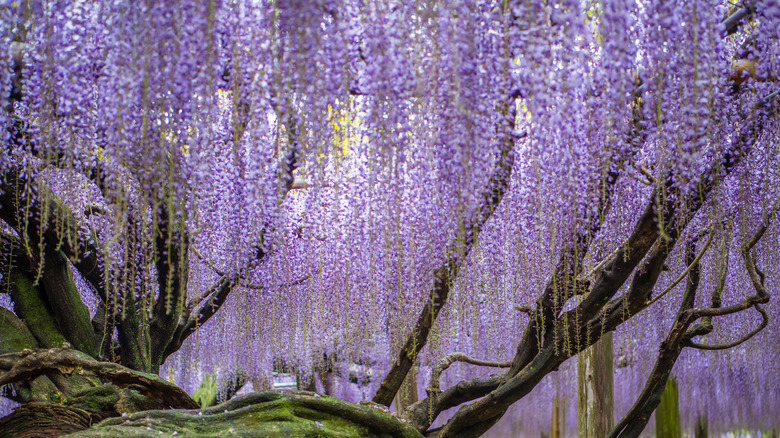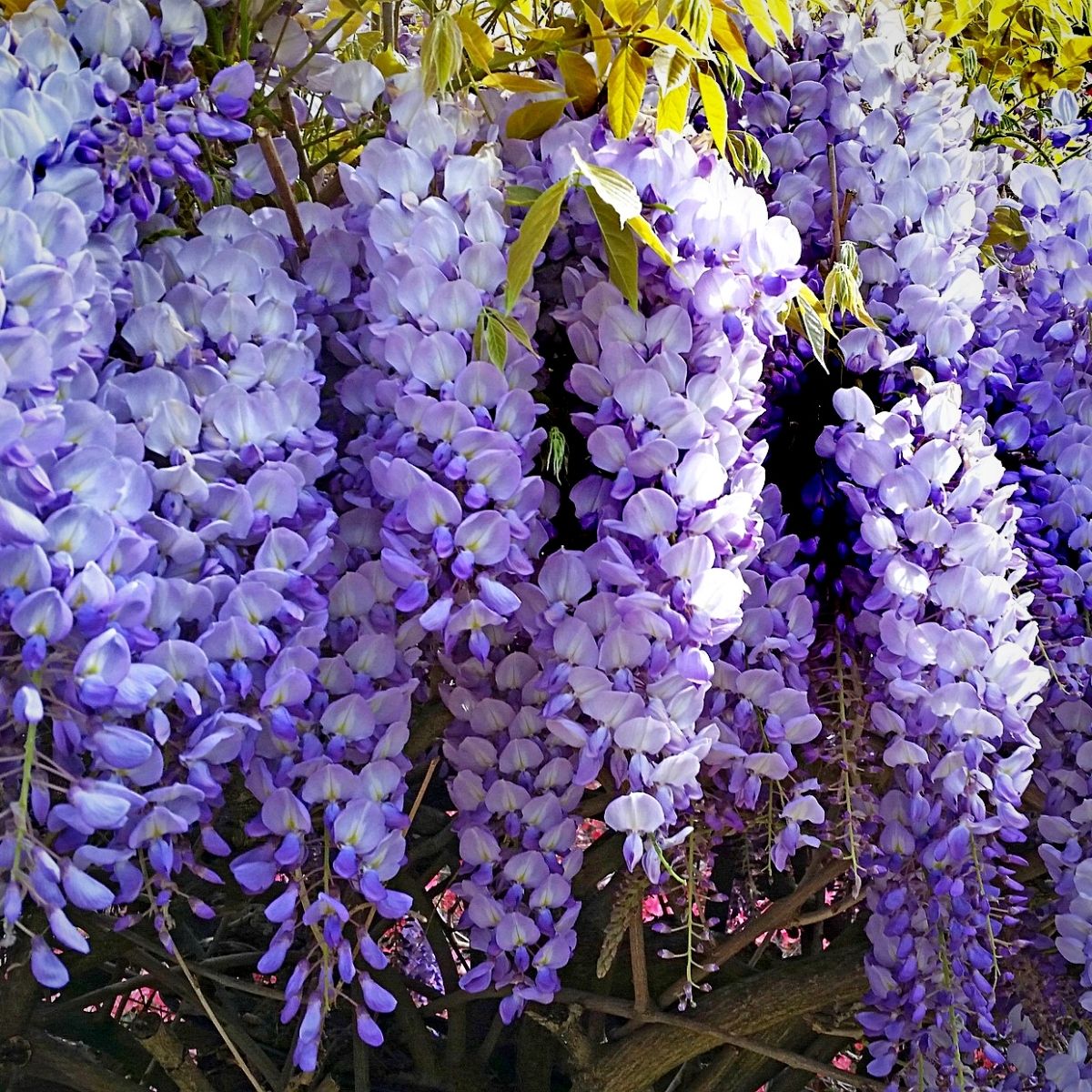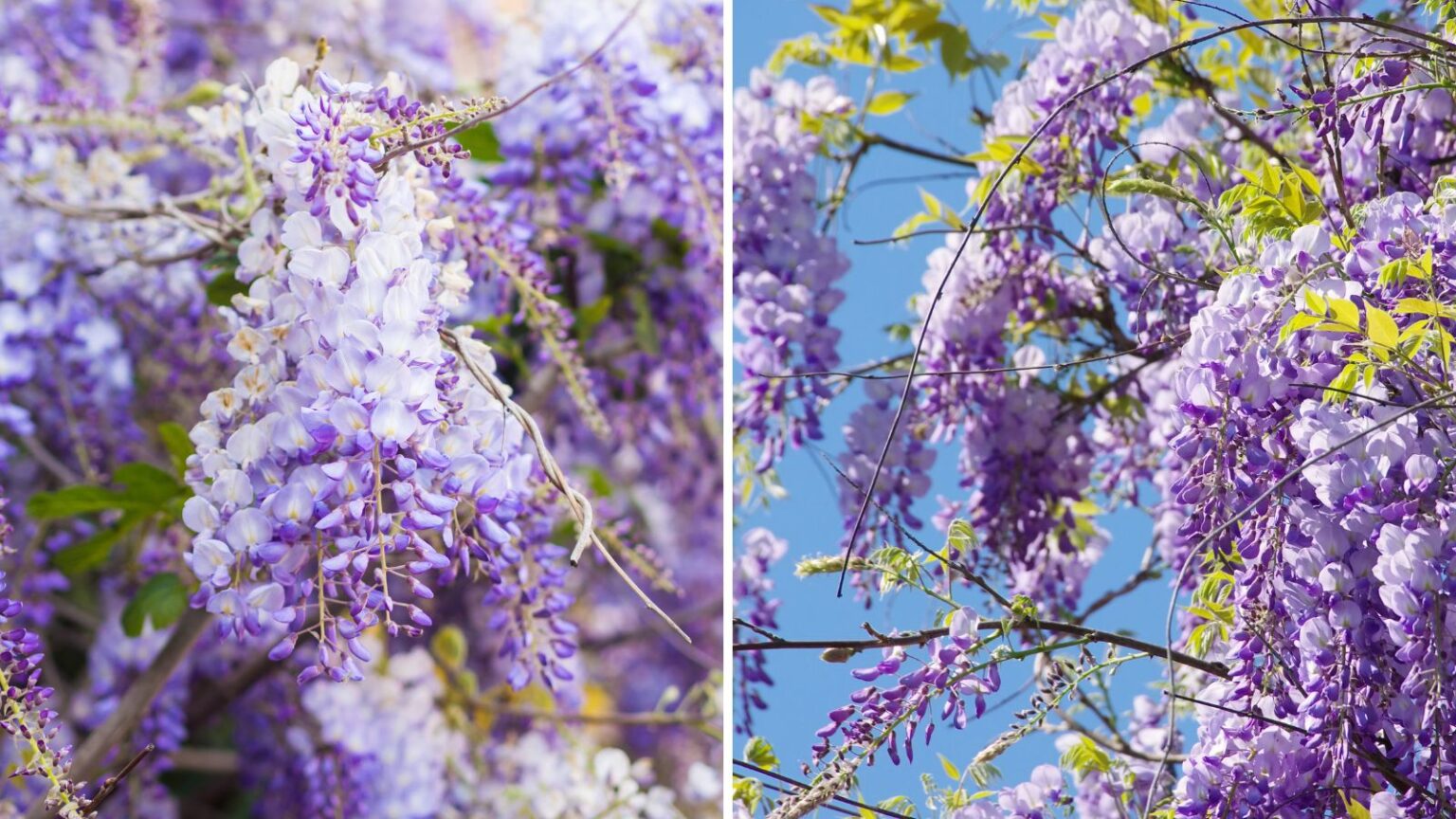Understanding Wisteria’s Growth Habits
Wisteria is a vigorous, fast-growing vine that can thrive in various conditions, making it a popular choice for gardeners and landscape designers. To unlock the secrets of wisteria growth, it’s essential to understand the plant’s natural habits and characteristics. Wisteria is a member of the Fabaceae family, which includes beans, peas, and lentils. This family is known for its ability to fix nitrogen in the soil, making wisteria a valuable addition to any garden ecosystem.
One of the most significant factors influencing wisteria growth is its ability to adapt to different environments. Wisteria can grow in a range of soils, from acidic to alkaline, and can tolerate various levels of sunlight and watering. However, optimal growth occurs in well-draining soil with full sun to partial shade. Understanding these preferences is crucial for creating an ideal environment for wisteria growth.
Wisteria’s growth rate is also influenced by its unique characteristics. The plant produces long, woody stems that can grow up to 10 feet per year, making it an excellent choice for trellises, arbors, and pergolas. Wisteria’s flowering habit is also noteworthy, with fragrant, purple flowers blooming in late spring. To encourage optimal growth and flowering, it’s essential to provide wisteria with regular pruning and training.
For those wondering how quickly do wisteria grow, the answer lies in its ability to thrive in optimal conditions. With proper care and attention, wisteria can grow up to 3 feet per month during the growing season. However, growth rates can vary depending on factors such as climate, soil quality, and pruning practices. By understanding wisteria’s growth habits and providing the right environment, gardeners can unlock the plant’s full growth potential.
Factors Affecting Wisteria Growth Rate
Wisteria growth rate is influenced by a combination of factors, including climate, soil quality, sunlight, watering, and pruning. Understanding how these factors impact the plant’s growth and development is crucial for optimizing its growth potential. Climate, for instance, plays a significant role in determining wisteria’s growth rate. Wisteria thrives in temperate climates with warm summers and cool winters, but it can also tolerate some frost. In areas with extreme temperatures, wisteria growth may be slower or more erratic.
Soil quality is another critical factor affecting wisteria growth rate. Wisteria prefers well-draining soil with a pH between 6.0 and 7.0. Soil with poor drainage or inadequate nutrients can lead to stunted growth or reduced flowering. Sunlight is also essential for wisteria growth, with most varieties requiring full sun to partial shade. However, excessive sunlight can cause leaf scorch and reduce growth.
Watering is another crucial factor, as wisteria requires consistent moisture to grow optimally. However, overwatering can lead to root rot and reduced growth. Pruning is also essential for promoting healthy growth and encouraging flowering. Regular pruning helps control the plant’s size, promotes new growth, and encourages the development of flower buds.
When considering how quickly do wisteria grow, it’s essential to remember that these factors can impact growth rates. For example, wisteria growing in ideal conditions with optimal climate, soil, sunlight, watering, and pruning can grow up to 3 feet per month during the growing season. However, growth rates can vary significantly depending on the specific conditions. By understanding and managing these factors, gardeners can optimize wisteria growth and promote healthy development.
In addition to these factors, wisteria growth rate can also be influenced by the specific variety. Some wisteria varieties are bred for their compact growth habit, while others are known for their vigorous growth and long vines. By choosing the right variety for your garden and providing optimal growing conditions, you can unlock your wisteria’s full growth potential.
How to Create an Ideal Environment for Wisteria Growth
Creating an ideal environment for wisteria growth is crucial for unlocking the plant’s full potential. To achieve this, it’s essential to mimic the plant’s natural habitat as closely as possible. Wisteria is native to China, Japan, and the Eastern United States, where it grows in woodland edges, along streams, and in rocky outcroppings. By replicating these conditions in your garden, you can provide your wisteria with the optimal environment for growth.
Choosing the right location is critical for wisteria growth. Wisteria prefers full sun to partial shade, so select a location that receives at least six hours of direct sunlight per day. However, in warmer climates, some afternoon shade can help prevent leaf scorch. Wisteria also thrives in well-draining soil, so avoid planting in low-lying areas where water may collect.
Preparing the soil is also essential for wisteria growth. Wisteria prefers a slightly acidic to neutral soil pH, ranging from 6.0 to 7.0. Test your soil to determine its pH level, and amend it if necessary. Add organic matter like compost or well-rotted manure to improve soil fertility and drainage. Wisteria also benefits from a layer of mulch around the base of the plant, which helps retain moisture and suppress weeds.
Providing adequate support is also crucial for wisteria growth. Wisteria is a vigorous climber, and it needs a sturdy trellis or arbor to support its weight. Choose a support that is at least 6 feet tall, and provide regular pruning to encourage the plant to grow upwards. By creating an ideal environment for wisteria growth, you can encourage healthy development and promote optimal growth rates.
When considering how quickly do wisteria grow, it’s essential to remember that the right environment plays a significant role. By providing your wisteria with the optimal conditions, you can unlock its full growth potential and enjoy its beautiful flowers and foliage for years to come.
Wisteria Growth Stages: What to Expect
Wisteria growth stages can be divided into several distinct phases, from germination to maturity. Understanding these stages is crucial for providing the right care and attention to your wisteria plant. The first stage is germination, which typically occurs within 1-3 weeks after sowing the seeds. During this stage, the seedling will develop its first set of leaves and begin to grow its root system.
The next stage is the seedling stage, which can last from 1-6 months. During this stage, the seedling will develop its second set of leaves and begin to grow its stem. It’s essential to provide the seedling with adequate light, water, and nutrients to promote healthy growth. The seedling stage is also a critical period for pruning and training, as it will help determine the plant’s overall shape and growth habit.
After the seedling stage, wisteria enters the sapling stage, which can last from 1-2 years. During this stage, the plant will continue to grow its stem and develop its root system. It’s essential to provide the sapling with regular pruning and training to encourage a strong, vigorous growth habit. The sapling stage is also a critical period for fertilization, as it will help promote healthy growth and flowering.
The final stage is the mature stage, which can last from 2-10 years or more. During this stage, the plant will reach its full growth potential and produce flowers and seeds. It’s essential to continue providing the plant with regular pruning and training to maintain its shape and promote healthy growth. The mature stage is also a critical period for pest and disease management, as the plant can be more susceptible to these issues.
When considering how quickly do wisteria grow, it’s essential to remember that the growth stages can vary depending on factors such as climate, soil quality, and pruning practices. By understanding the different growth stages and providing the right care and attention, you can promote healthy growth and flowering in your wisteria plant.
Pruning and Training for Optimal Growth
Pruning and training are essential for promoting optimal growth and flowering in wisteria. Pruning helps control the plant’s size, encourages new growth, and promotes flowering. Training, on the other hand, helps the plant grow in a desired direction and maintain its overall shape. By pruning and training your wisteria regularly, you can unlock its full growth potential and enjoy its beautiful flowers and foliage.
There are several pruning techniques that can be used to promote optimal growth in wisteria. One of the most common techniques is to prune the plant in the late winter or early spring, removing any dead or damaged branches. This helps promote new growth and encourages the plant to produce more flowers. Another technique is to prune the plant after it has finished flowering, removing any spent flowers and trimming back the stems to encourage new growth.
Training is also an important aspect of wisteria care. Wisteria is a vigorous climber, and it needs a sturdy trellis or arbor to support its weight. By training the plant to grow up the trellis or arbor, you can promote optimal growth and flowering. You can also use training to control the plant’s size and shape, and to encourage it to grow in a desired direction.
When pruning and training your wisteria, it’s essential to remember that the plant is sensitive to over-pruning. Over-pruning can stress the plant and reduce its growth rate, so it’s essential to prune only what is necessary. It’s also essential to use the right pruning tools and techniques to avoid damaging the plant.
By pruning and training your wisteria regularly, you can promote optimal growth and flowering, and enjoy its beautiful flowers and foliage for years to come. When considering how quickly do wisteria grow, it’s essential to remember that pruning and training play a critical role in promoting healthy growth and flowering.
Common Challenges and Solutions for Wisteria Growth
Wisteria growth can be affected by several common challenges, including pests, diseases, and nutrient deficiencies. These challenges can impact the plant’s overall growth and development, and may even lead to reduced flowering or plant death. However, by understanding the causes of these challenges and implementing effective solutions, you can promote healthy growth and flowering in your wisteria.
One of the most common pests that can affect wisteria growth is the Japanese beetle. These beetles can cause significant damage to the plant’s leaves and flowers, and can even spread disease. To control Japanese beetles, use a combination of cultural and chemical controls, such as hand-picking, insecticidal soap, and pyrethrin sprays.
Wisteria is also susceptible to several diseases, including powdery mildew, leaf spot, and root rot. These diseases can be caused by a variety of factors, including fungal infections, bacterial infections, and environmental stress. To control diseases, use a combination of cultural and chemical controls, such as removing infected leaves, improving air circulation, and applying fungicides.
Nutrient deficiencies can also impact wisteria growth, particularly if the soil lacks essential nutrients like nitrogen, phosphorus, and potassium. To address nutrient deficiencies, use a balanced fertilizer that contains all the essential nutrients, and follow the recommended application rates.
When considering how quickly do wisteria grow, it’s essential to remember that common challenges can impact growth rates. By understanding the causes of these challenges and implementing effective solutions, you can promote healthy growth and flowering in your wisteria. Regular monitoring and maintenance can also help prevent common challenges and ensure optimal growth.
Wisteria Varieties: Choosing the Right One for Your Garden
Wisteria is a diverse genus with many different varieties, each with its unique growth habits and characteristics. When choosing a wisteria variety for your garden, it’s essential to consider factors like climate, space, and desired growth rate. Some popular wisteria varieties include Chinese wisteria (Wisteria sinensis), Japanese wisteria (Wisteria floribunda), and American wisteria (Wisteria frutescens).
Chinese wisteria is a fast-growing variety that can thrive in a variety of conditions. It produces long, fragrant flowers in shades of purple and white, and can grow up to 10 feet per year. Japanese wisteria is a slower-growing variety that produces shorter, more delicate flowers in shades of pink and white. American wisteria is a compact variety that produces shorter, more fragrant flowers in shades of purple and white.
When considering how quickly do wisteria grow, it’s essential to remember that different varieties have different growth rates. Chinese wisteria is one of the fastest-growing varieties, while Japanese wisteria is slower-growing. American wisteria is a compact variety that grows more slowly than Chinese wisteria but faster than Japanese wisteria.
In addition to growth rate, it’s also essential to consider factors like climate, space, and desired growth habit when choosing a wisteria variety. Chinese wisteria thrives in warm, sunny climates, while Japanese wisteria prefers cooler, more shaded conditions. American wisteria is a versatile variety that can thrive in a variety of conditions.
By choosing the right wisteria variety for your garden, you can promote healthy growth and flowering, and enjoy the beauty of these stunning plants for years to come.
Conclusion: Unlocking Wisteria’s Full Growth Potential
In conclusion, understanding wisteria’s growth habits and creating an ideal environment for optimal growth are crucial for unlocking the plant’s full potential. By considering factors like climate, soil quality, sunlight, watering, and pruning, you can promote healthy growth and flowering in your wisteria. Additionally, choosing the right variety for your garden and addressing common challenges can help ensure optimal growth and flowering.
When considering how quickly do wisteria grow, it’s essential to remember that different varieties have different growth rates. However, by providing the right conditions and care, you can promote healthy growth and flowering in your wisteria, regardless of the variety.
Experimenting with different techniques and varieties can also help you unlock your wisteria’s full growth potential. Try different pruning and training methods, and consider using different varieties in your garden. By doing so, you can create a stunning and thriving wisteria display that will provide beauty and enjoyment for years to come.
Remember, wisteria is a versatile and adaptable plant that can thrive in a variety of conditions. By understanding its growth habits and creating an ideal environment, you can unlock its full growth potential and enjoy its beauty and fragrance for years to come.



/wisteria-blooms-on-archway-9cc0a86a174248c897fe4bbb1b6b6e6a.jpg)



:max_bytes(150000):strip_icc()/wisteria-growing-guide-5207953-02-8a6be5ec711243f0ac2a821765a71b6f.jpg)

